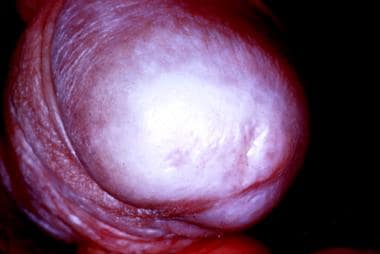Practice Essentials
Balanitis is inflammation of the glans penis and is a common condition that affects an estimated 3-11% of males. [1] Balanitis can occur in males at any age. Morbidity is associated with the complications of phimosis. [2, 3, 4] Balanitis involving the foreskin and prepuce is termed balanoposthitis. According to European guidelines outlining the current management of balanoposthitis, the aims of management are to minimize sexual dysfunction and urinary dysfunction, exclude penile cancer, treat premalignant disease, and diagnose and treat sexually transmitted infections. [5]
Predisposing factors include poor hygiene and overwashing, use of over-the-counter medications, and nonretraction of the foreskin. [5] Though uncommon, a complication of balanitis (usually only in recurrent cases) is constricting phimosis, or inability to retract the foreskin from the glans penis. Other complications of balanitis may include meatal stenosis and possible urethral strictures, urinary retention, and vesicoureteral reflux.
Balanitis xerotica obliterans (BXO), or penile lichen sclerosus, is a progressive sclerosing inflammatory dermatosis of the glans penis and foreskin (see the image below). BXO is uncommon in children. [2, 3, 4, 6, 7, 8]
 Balanitis xerotica obliterans (lichen sclerosus). Courtesy of Wilford Hall Medical Center Slide collection.
Balanitis xerotica obliterans (lichen sclerosus). Courtesy of Wilford Hall Medical Center Slide collection.
Uncircumcised men with poor personal hygiene are most affected by balanitis. Lack of aeration and irritation because of smegma and discharge surrounding the glans penis causes inflammation and edema. Though uncommon, complications of balanitis include phimosis and cellulitis. Meatal stenosis with urinary retention may rarely accompany balanitis. In very few cases, balanitis may contribute to the "buried penis syndrome." Diabetes is the most common underlying condition associated with adult balanitis. [9, 10, 11] Older age has been identified as a risk factor for candidal balanitis.
Zoon balanitis (balanitis circumscripta plasmacellularis) is an inflammatory condition that is thought to result from chronic irritation and that presents as a well-demarcated shiny erythematous patch or plaque over the genital mucosa. [11] It typically occurs in middle-aged and older men who are uncircumcised. Because Zoon balanitis often complicates other dermatoses — especially lichen sclerosus, but also precancerous lesions and cancer— its frequency, and even its existence as an independent entity, has been called into question. [5, 12]
Etiology
Diabetes mellitus is the most common underlying condition associated with balanitis in adults. [9] In a study of patients with type 2 diabetes mellitus, treatment with dapagliflozin (a selective sodium-glucose transporter–2 [SGLT2] inhibitor that increases urinary glucose excretion) was found to be associated with an increased risk of vulvovaginitis or balanitis, related to the induction of glucosuria. According to the authors, events were generally mild to moderate, were clinically manageable, and rarely led to discontinuation of treatment. For dapagliflozin 5 mg and 10 mg daily, infections were reported in 5.7% and 4.8% of patients, respectively, as compared to 0.9% in patients with type 2 diabetes who were given placebo. [13, 14]
Other causes include the following [15] :
-
Poor personal hygiene
-
Chemical irritants (eg, soap, petroleum jelly)
-
Edematous conditions, such as congestive heart failure (right-sided), cirrhosis, and nephrosis
-
Drug allergies (eg, tetracycline, sulfonamide)
-
Morbid obesity
Pathogens that can cause balanitis include the following:
-
Candidal species (most commonly associated with diabetes)
-
Group B and group A beta-hemolytic streptococci
-
Neisseria gonorrhoeae
-
Chlamydia species
-
Anaerobes (eg, Bacteroides)
-
Human papillomavirus
-
Gardnerella vaginalis
-
Treponema pallidum (syphilis)
-
Trichomonal species
-
Borrelia vincentii and Borrelia burgdorferi
-
Balanitis xerotica obliterans (lichen sclerosus). Courtesy of Wilford Hall Medical Center Slide collection.

